
|
The
Arcane Art
|

|
|
|
|
|

Well, I guess I broke the budget on this one! In real life, there’s no way the
exterior scenes could be filmed as described. Forever Knight just never had
the budget to be able to afford a couple of hundred extras, which is what would be
required. Some fudge would be performed: medium angle shots on small crowds
standing in for the full high-angle shots of the entire scene. You could still
get the shots of the school building, of course. But for once I decided to give
you the ideal. For once in Season IV, enjoy a scene as envisioned, without the limitations of budget.
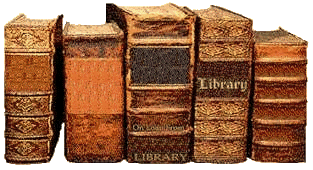
The origin of “The Arcane Art’ lies with the scene in the Epilogue where LaCroix insists that
Nick learn to read. I’m not sure exactly when I wrote it; but it was certainly years before
I began writing the episode as a whole. I often write down individual scenes that occur to
me, and save the files in the hope that someday I will be able to fit them in somewhere in an
episode that, at that time, I probably haven’t even thought of.
 (I used up quite a few of these files when I cobbled together “The Kiss of Death”. But
then, I’ve written quite a few more orphan scenes since.)
(I used up quite a few of these files when I cobbled together “The Kiss of Death”. But
then, I’ve written quite a few more orphan scenes since.)
Thinking about literacy made me wonder about the way Vachon tends to use long words now and
then—words that Screed and Urs don’t understand. I thought that, since his formal
education, whatever it might have been, could hardly be up to date, perhaps he
 was an autodidact. In which case, he probably spent time in libraries. Which,
given the characterization of the other members of his “crew” (with the possible exception of
Urs), would perplex them no end. So scenes with Vachon and Screed in the library started
to suggest themselves, though I didn’t write anything down at that point. Obviously, when two
flashbacks are so similar in theme, they can’t be put in separate episodes without it looking
as though one is repeating oneself. So I began to suspect that I was going to have to fit
two flashbacks into the episode. When one has two full-sized flashbacks to fit in,
the prospect is rather daunting. In the event, as you will have noticed, the library scenes
turned out rather skimpy.
was an autodidact. In which case, he probably spent time in libraries. Which,
given the characterization of the other members of his “crew” (with the possible exception of
Urs), would perplex them no end. So scenes with Vachon and Screed in the library started
to suggest themselves, though I didn’t write anything down at that point. Obviously, when two
flashbacks are so similar in theme, they can’t be put in separate episodes without it looking
as though one is repeating oneself. So I began to suspect that I was going to have to fit
two flashbacks into the episode. When one has two full-sized flashbacks to fit in,
the prospect is rather daunting. In the event, as you will have noticed, the library scenes
turned out rather skimpy.
Two possible main plots occurred to me: a murder in a library, and a murder at a
night-school literacy class. For a long time, I toyed with the former. If I had
used it, I would have set the story at the Toronto Reference Library, since I had a part-time job
there once, though not at its present site. But somehow, when I started to juggle ideas and
try to fit them together, the night-school plot started to fit faster. The episode was finished
in January 2000, the last of a cluster that I completed in the fall and early winter after my
father died.

The other scene that was prewritten was the one between Vachon and Urs, commenting on Tracy’s
asking Nick, in the Christmas episode, if he had a boyfriend. This was slated to go into
Episode Twelve, whatever Episode Twelve turned out to be. If that seems an odd way to
put it, I assure you it is not. For a long time, I had a rough order for Season IV
that had an episode called “Vultures of War” as Episode Twelve. According to this
rough order of episodes, “The Arcane Art” was going to be put later in the season. Then
I wrote an episode called “Broken Hearts” in January 1999; and it immediately became obvious
that the scene in which LaCroix insists Nick learn to read belonged before “Broken
Hearts”. So I decided to substitute “The Arcane Art” for “Vultures of War”. (As
it turned out, “Vultures of War” isn’t in Season IV at all.)

|
|
|
|
|
|

SPECIAL NOTE
The French in the Historical Scenes
These are the first scenes in Season IV in which there are extensive passages of dialogue in
French. This is not intentional: it just happens that I have not, so far, had any flashbacks in
which this use of French seemed necessary. Perversely, you’ll get French in both the next two episodes,
also.
In the series, of course, you got subtitles. These are kind of hard to put
on a page of writing, so initially I didn’t bother. But I’m assuming that at least some “viewers” of
this virtual Season IV don’t know French, so I’ve put subtitles in as best I can—in the form of a column beside the spoken speech.
I’m sure to a native speaker this must sound like baby French. I make no
claims for its accuracy or grammaticality. I just took it at school (and we all know what that
means). I’ve tortured it out of a dictionary, and my meagre memory of lessons.
French is one of those languages that has a polite and a familiar form of the second person.
Although today the usage is less strict than it once was, it used to be extremely important to address
people properly. If one used the familiar form to a superior, it was grossly insulting, and could get you
in a lot of trouble.
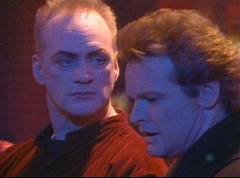
It seems to me that there are, even today, remnant signs of status difference in the way Nick and LaCroix address each other. LaCroix addresses Nick as “Nicholas” but receives “LaCroix”. It is the superior who uses the inferior’s personal name. The inferior never uses the superior’s personal name. It would startle the viewers as well as LaCroix if Nick were to address him as “Lucien”. It may happen occasionally in
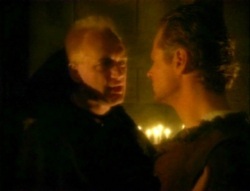 fan fiction—but not actually on screen.
fan fiction—but not actually on screen.
That being the case, the status difference between the two vampires would have been
even more marked in the Middle Ages. LaCroix was Nick’s master. Not only would he have expected
to be addressed in the polite form (“vous”), but Nick himself—a child of the times—would assume that he should use the polite form to the older man who was his mentor and quasi-father. Conversely, LaCroix would assume the familiar address (“tu”) when speaking to Nick; and Nick would never doubt his right to do so. In fact, in the show itself, this is canonically the situation.

|
|
|
|
|
|

THE PROLOGUE
The structure of “The Arcane Art” is odd. As a general rule, when people do a
story like this one, they start with the events that I put at the end of Act One. After
all, if the plot is a hostage-taking, then surely the obvious Prologue is its start.
But I had that scene with Vachon and Urs to fit in. And that meant that I had to contrive
circumstances for Vachon to learn from Tracy about her conversation with Nick. I also
wanted to put in a follow-up on the Christmas party with Nick and Natalie. Yet, obviously,
once they got stuck into police work at a hostage scene, there'd be no way either Nick or Tracy
could take time out for such personal discussions.
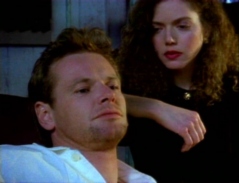
Could the scenes be put in the Epilogue? In other episodes (for example “Glowing Embers” and “Death Shall Be No More”), I had delayed scenes about Janette in this way, since they did not fit inside the main plot. But the main plot of “The Arcane Art” hinges on the illiteracy of Emil Murdoch, which obviously has to be kept a secret until Act Five. That meant that it was the medieval scenes that had to go in the Epilogue. Furthermore, comments on a preceding episode properly belong to the beginning of a show. Yet they could not go in the Prologue, since Forever Knight always has suspenseful prologues. This meant that the Christmas follow-ups had to be put in Act One. Nick and Tracy therefore had to be off-duty in Act One. And that meant that the hostage-taking incident could not be a police case in Act One. The real action could not start until Act Two. I could, of course, drag out its preliminaries (as indeed I did). That certainly gave Act One an exciting close. But how could I open the episode?
You see, there is a reason why the informal name for the Prologue is the “Teaser”. It
has to “tease” the viewer, especially the casual viewer, into watching on. So that was
one reason why I had Vachon pick someone up at the Raven and—apparently (so far as
the Prologue shows you)—kill her during vampire-style sex. It gives a nicely nasty,
crime-like opening to the show, even if it actually turns out to have nothing whatsoever to do with the plot.
The other reason, of course, has to do with Vachon’s comment to Urs that, in his experience, he’s “damn near everyone’s type”.
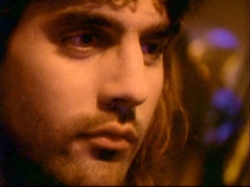 If so, then presumably he’s had guys hit on him. How has he responded?
If so, then presumably he’s had guys hit on him. How has he responded?
Old viewers know that, in the Season III episode, “My Boyfriend is a Vampire’, Vachon and his friends, Screed and Bourbon, seduce and kill a group of women.
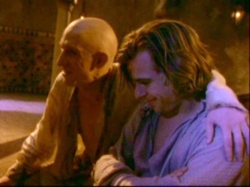 Afterwards, he says to the others with evident pleasure that he “loves women”. Newcomers,
on the other hand, have had no real evidence so far regarding Vachon’s sexual preferences.
Afterwards, he says to the others with evident pleasure that he “loves women”. Newcomers,
on the other hand, have had no real evidence so far regarding Vachon’s sexual preferences.
Of course, this would not in any way preclude his also being interested in men. One swallow does not a summer make.

|
|
|
|
|
|
|
Murdoch’s Illiteracy
It is important to understand that Emil Murdoch does not kill his girlfriend because he is illiterate. He kills her because he is ashamed of being illiterate. When he feels that shame, he gets angry. And, rather than take steps to rid himself of shame by alleviating his illiteracy, he blames whoever he considers has caused the situation that has made him feel inadequate. He blames Annette, who wants to share the pleasure of her evening class, and the teacher whose love of literature has led to Annette’s enjoyment.
Yet, in a global or historical context, the stigma of illiteracy is a recent phenomenon limited to the developed world. Nick, in medieval times, saw no shame in
 being unable to read—though, admittedly, for a man of his class that period was quickly drawing to a close. By century’s end, most European nobility were literate. But, until very recently, most people in the world got by just fine without reading and writing.
being unable to read—though, admittedly, for a man of his class that period was quickly drawing to a close. By century’s end, most European nobility were literate. But, until very recently, most people in the world got by just fine without reading and writing.
Today, of course, things are very different. Most people in Western countries are exposed to literacy teaching at an early age. And some display such a talent for the skill that, in a world where writing is ubiquitous, mere exposure to it is sufficient for their brains to correlate print and sound. Where some children labour hard to learn to read, others can read before going to school, even when they have received no formal instruction.
But there are others, like Emil Murdoch, whose brains simply aren’t hardwired to make the necessary connections, at least not without special assistance, For some, their minds are not easily able to connect visual shapes with speech sounds. They may perhaps be able to be taught to learn to read through their other senses. Others have brains that focus on the similarities between shapes rather than the differences, making it easy for them to confuse letters that differ only in their orientation, such as p, b, d, and printed q. In another time or place, such people would probably have not even have known that they had a “learning disability”. They would still have been able to learn the skills needed to be a potter, carpenter, fletcher, thatcher, smith—or knight.
They would still have been illiterate. Like almost everyone else. So, of course, they would not have felt any shame in it.

|
|
|
|
|
|
|
Other Plotting
|

|
 When Reese says on the phone to Murdoch that “[A]fter all …the situation’s not as bad as it could be, y’know”, he’s being disingenuous. Of course, by now he knows there’s a corpse in the guy’s house! But he doesn’t want Murdoch knowing they know. If he believes the police don’t know he’s a murderer, and thinks they think he hasn’t killed anyone yet, then he’ll think they’ll be less likely to start shooting at him. And that’ll mean that he’ll be less likely to panic and himself start shooting. Reese is trying to keep the situation as low-key as possible.
When Reese says on the phone to Murdoch that “[A]fter all …the situation’s not as bad as it could be, y’know”, he’s being disingenuous. Of course, by now he knows there’s a corpse in the guy’s house! But he doesn’t want Murdoch knowing they know. If he believes the police don’t know he’s a murderer, and thinks they think he hasn’t killed anyone yet, then he’ll think they’ll be less likely to start shooting at him. And that’ll mean that he’ll be less likely to panic and himself start shooting. Reese is trying to keep the situation as low-key as possible.
 Clues that Murdoch is illiterate:
Clues that Murdoch is illiterate:
 What! Tracy takes a bottle of beer from Murdoch’s fridge? Well, notoriously, cops do (or are reputed to do) this sort of thing in this sort of situation. It is a sign that Tracy is well socialized in cop culture—old-style cop culture—as she would
What! Tracy takes a bottle of beer from Murdoch’s fridge? Well, notoriously, cops do (or are reputed to do) this sort of thing in this sort of situation. It is a sign that Tracy is well socialized in cop culture—old-style cop culture—as she would
 be, being from a police family. Tracy’s behaviour in Murdoch’s kitchen is intended to tie into her upbringing—daughter of a cop, whose uncles are all cops, whose grandfather is a cop.
be, being from a police family. Tracy’s behaviour in Murdoch’s kitchen is intended to tie into her upbringing—daughter of a cop, whose uncles are all cops, whose grandfather is a cop.
Of course, she’d never touch the fridge until it was fingerprinted. But note the staging: the people from the Forensic Identification Unit have at this point left the house. So, as far as she is concerned, she is now free to touch what she pleases. Nick and Tracy are only hanging around until the detective back at the squad room calls them with the info about Murdoch’s job. So she’s bored waiting.
As for her drinking on duty: remember that, back in “Crimson Joy”, she wished Vachon could offer her a cold beer rather than pop, and this was shortly before she would be going to work. To her, this is the social beverage. (Or is she her mother’s daughter, too?) But she is too professional to have more than one.

|
|
|
|
|
|
|
Continuity
|
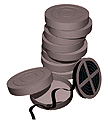
|
 The composite artist, Hardy, appeared briefly in “Crimson Joy”.
The composite artist, Hardy, appeared briefly in “Crimson Joy”.

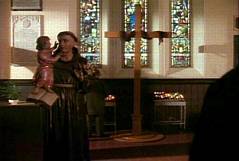 Yes, this is the same St. John&rsqo;s Church we’ve seen before in the series. It appeared in the first season episode, “For I Have Sinned”, and the third season episode, “Games Vampires Play” (though, admittedly, the actual film sites were two different locations). A large downtown Catholic church, it has at least two priests assigned to work there.
Yes, this is the same St. John&rsqo;s Church we’ve seen before in the series. It appeared in the first season episode, “For I Have Sinned”, and the third season episode, “Games Vampires Play” (though, admittedly, the actual film sites were two different locations). A large downtown Catholic church, it has at least two priests assigned to work there.
 Remember how I absolutely had to fit in those little scenes in “Glowing
Embers” and “Death Shall Be No More” where Nick flew off and left Tracy stranded? This
episode was, of course, written first. I immediately realized that, if Tracy was
complaining about Nick doing it to her “again”, then there would have to have been previous
Remember how I absolutely had to fit in those little scenes in “Glowing
Embers” and “Death Shall Be No More” where Nick flew off and left Tracy stranded? This
episode was, of course, written first. I immediately realized that, if Tracy was
complaining about Nick doing it to her “again”, then there would have to have been previous
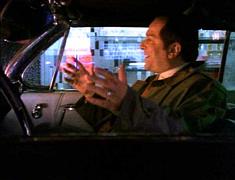
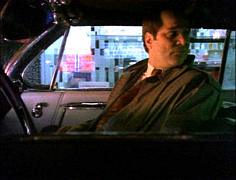 occasions. He was always disappearing on his first partner, Don
Schanke, in exactly the same way.
occasions. He was always disappearing on his first partner, Don
Schanke, in exactly the same way.
Naturally, Nick prefers the speed of flight in an
emergency. But Schanke didn’t know Nick was a vampire any more than Tracy does; and
Nick’s disappearances were a constant irritatation. It was a running gag throughout
the first two seasons. But I couldn’t recall any scenes in the real Forever Knight
where he did it to Tracy. In any case, even if there were any, they would not necessarily
be accessible to new “viewers”. I therefore wrote a couple of little scenes to appear in
earlier (at that time yet unwritten) episodes, so that there would be a thread running through
the first half of the season leading to this confrontation.
 I don’t think, in the actual series, we ever saw LaCroix abuse Janette in the way
I don’t think, in the actual series, we ever saw LaCroix abuse Janette in the way
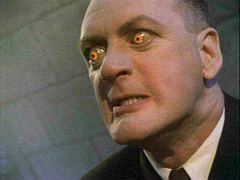 he—almost routinely—did Nick. This is, of course, partly because it was Nick who kept
aggravating him. But it may also have been because the people making the series felt that violence against another man is less serious than violence against a woman: you’re
he—almost routinely—did Nick. This is, of course, partly because it was Nick who kept
aggravating him. But it may also have been because the people making the series felt that violence against another man is less serious than violence against a woman: you’re
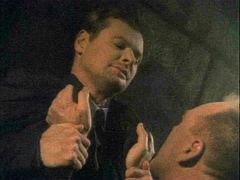 always seeing guys fight on TV.
always seeing guys fight on TV.
In medieval times, most people didn’t feel that violence against a dependent (including a child, a student, a servant, or an apprentice) was improper or unreasonable. So why should LaCroix? This sort of behaviour was all too common back in those days.

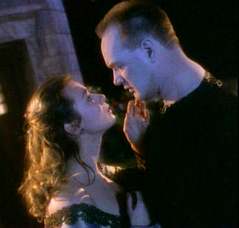 Nick’s younger sister, Fleur, was introduced in the second season episode, “Be My Valentine”, which told the story of LaCroix’s thwarted love for her. Even when told of his undead state, Fleur remained in love with him. But Nick, who wanted his sister to live a mortal life untainted by the evil that he believed to be inherent in the vampire state, begged LaCroix to leave Brabant without bringing her across. LaCroix reluctantly agreed for Nick’s sake. In the end, Fleur died young.
Nick’s younger sister, Fleur, was introduced in the second season episode, “Be My Valentine”, which told the story of LaCroix’s thwarted love for her. Even when told of his undead state, Fleur remained in love with him. But Nick, who wanted his sister to live a mortal life untainted by the evil that he believed to be inherent in the vampire state, begged LaCroix to leave Brabant without bringing her across. LaCroix reluctantly agreed for Nick’s sake. In the end, Fleur died young.

|
|
|
|
|
|
|
Night School
|

|
 If we take Season IV as being shown in real time, it’s the second week or so of January at this point. In semestered schools, the fall semester runs until the end of January, with exams in the last week.
If we take Season IV as being shown in real time, it’s the second week or so of January at this point. In semestered schools, the fall semester runs until the end of January, with exams in the last week.
 When I taught night school for the Toronto Board of Education, it was indeed the practice for attendance to be taken to the office during the break.
When I taught night school for the Toronto Board of Education, it was indeed the practice for attendance to be taken to the office during the break.
 When the principal exclaims, “But this is a night school”, this is not as silly as it might seem at first glance. By their very nature, night schools only get students who are voluntary attendees; and they are often older than the usual high-school age. If they are taking a non-credit course, it may be something useful like driver ed, or English as a second language, or, of course, a literacy program. Or something fun like art or Chinese cooking. If they are taking credit courses then they are either:
When the principal exclaims, “But this is a night school”, this is not as silly as it might seem at first glance. By their very nature, night schools only get students who are voluntary attendees; and they are often older than the usual high-school age. If they are taking a non-credit course, it may be something useful like driver ed, or English as a second language, or, of course, a literacy program. Or something fun like art or Chinese cooking. If they are taking credit courses then they are either:
 in the last years of high school, trying for an extra credit, or retaking a course they got a low mark in; or
in the last years of high school, trying for an extra credit, or retaking a course they got a low mark in; or
 they are adults who need the course for work, or as a prerequisite for getting into a particular college or university program, or who dropped out but have now decided to finish high school.
they are adults who need the course for work, or as a prerequisite for getting into a particular college or university program, or who dropped out but have now decided to finish high school.
|
The classic school-shooter profile is that of a kid who is an outsider, bullied by the other students, depressed to the point of being suicidal, but wanting revenge at the same time. Night-school students don’t usually fit this profile.

|
|
|
|
|
|
 Canadian Content
Canadian Content

 When Devereaux says, “We got out here to find the school coming down to the pavement”, his use of the term “pavement” rather than sidewalk suggests that he is not a native-born Canadian.
When Devereaux says, “We got out here to find the school coming down to the pavement”, his use of the term “pavement” rather than sidewalk suggests that he is not a native-born Canadian.
 There are dialect differences in the terms for lavatories, so perhaps I should make it clear that, in Canada, “washroom” is usually used for public facilities, such as those in schools or shopping centres, not those in private homes.
There are dialect differences in the terms for lavatories, so perhaps I should make it clear that, in Canada, “washroom” is usually used for public facilities, such as those in schools or shopping centres, not those in private homes.
 In Toronto, the term is “library card”, so that is what Tracy says. But there are, of course, other places where the term is “library ticket”—an indication that Vachon has been to other libraries in other cities.
In Toronto, the term is “library card”, so that is what Tracy says. But there are, of course, other places where the term is “library ticket”—an indication that Vachon has been to other libraries in other cities.

|
|
|
|
|
|
Return to Top
Return to Episode Listings
Episode Twelve Homepage |
Episode Guide |
Home
|
Forever Knight and all characters
and images from the original series are the property of Sony/Tristar. No copyright
infringement is intended.
The picture of Nick & LaCroix from "The Human Factor" appears courtesy of
Kristin Harris.
The other pictures come from the
Episode Archives, and appear courtesy of Nancy
Taylor.
The fancy brown background, paper and leather graphics, pencil divider, and beige squares
come from and/or were made at GRSites.com.
The gold squirl comes from
Flamin’s Florals.
The various books, globe, jug of pencils, film canisters, and quill pens come from
J’s Magic Graphics Gallery.
The beer stein came originally from
www.free-clipart.net; and had its colour and
size altered at
GRSites.com.
The maple leaf comes from Canadian Flag Clip Art
Gallery.
All original material on this webpage copyright © Greer Watson 2004,
2005, 2006, 2009, 2011, 2012, 2023.
|
|